Have you ever looked at the front of a food package or at the nutrition label on the back and wondered why the numbers don’t add up or why the label doesn’t make much sense? In many cases it’s not because they’re incorrect, but because food labeling regulations can be quite confusing and result in some not-so-straightforward labels.
Here are four labeling regulations you may not know about that can help to explain some of the confusion regarding food labels:
1. Protein Percent Daily Value
You may have never noticed, but many food products don’t list the percent daily value for protein. That’s because it’s not required unless there is a protein claim made on the food package.
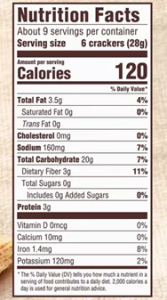
If there is a protein claim made on the package, such as “10g Protein per Serving” or “High Protein,” or an implied claim such as “High in Whey Protein,” it is required per U.S. Food and Drug Administration regulations to include the percent daily value for protein on the nutrition panel, however, it’s not a simple calculation of the grams of protein divided by the daily value of protein, which is 50g.
In order to determine the percent daily value of protein for a food product, what is known as the PDCAAS or protein digestibility corrected amino acid score is multiplied by the declared amount of protein for that product. PDCAAS adjusts for the quality of the protein and is based on the amino acid profile as well as the overall digestibility. PDCAAS values range from 0.0 to 1.0 with 1.0 being the highest score. A protein source with a PDCAAS value of 1.0 would generally be considered fully digestible in humans.
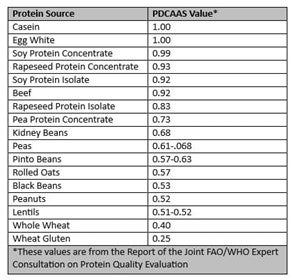
Here’s an example of a product with a protein claim on the front of the package. As you can see, they also list the %DV, as required, and because of the PDCAAS correction, the %DV is less than the total protein (12g) divided by the daily value (50g). That value without taking the PDCAAS into account would be 24 percent, but you can see it’s listed as 17 percent. That’s due to the PDCAAS correction.
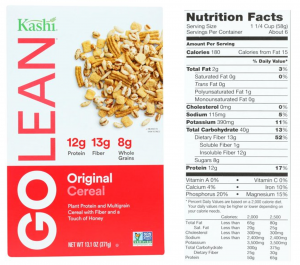
2. Standards of identity
Standards of identity (SOI) exist for certain foods that define what the food product must contain and how it must be proportioned in order to be labeled with the standardized name. Products such as “milk chocolate,” “bread,” and even “ketchup” all have standards of identity.
A food package can be labeled with a standardized name for which a SOI has been established only if it complies with the applicable SOI. For example, the FDA SOI for milk chocolate can be found here. It establishes that milk chocolate must contain not less than 10 percent by weight of chocolate liquor, not less than 3.39 percent by weight of milkfat, and not less than 12 percent by weight of total milk solids, among some additional requirements. There are SOIs for other cacao products as well. So, let’s say a company is using a chocolate coating that doesn’t meet the SOI to be called “chocolate.” You may notice these foods labeled with words like “chocolatey” instead of “chocolate.” This is usually because the chocolate ingredient they’re using doesn’t meet the SOI for chocolate.
That’s not to say that a product that doesn’t meet a certain SOI is not “real” food or is worse than another product that does meet the SOI, rather, SOIs can provide consumers with the assurance that they will get what they may reasonably expect to receive.
The product shown below has chocolate chips that do meet the SOI for chocolate, which is why they can say “real chocolate chips,” however, the chocolate coating on the outside of the bar does not, which is why the bottom of the box states “chocolatey covered granola bars.”

3. ‘Naturally flavored with other natural flavors’
Have you ever seen a food package that says “naturally flavored with other natural flavors” and wondered what the heck that means? CFR Title 21 Part 101.22 states:
“If the food is one that is commonly expected to contain a characterizing food ingredient, e.g., strawberries in ‘strawberry shortcake,’ and the food contains natural flavor derived from such ingredient and an amount of characterizing ingredient insufficient to independently characterize the food, or the food contains no such ingredient, the name of the characterizing flavor may be immediately preceded by the word ‘natural’ and shall be immediately followed by the word ‘flavored.'”
OK, that may seem confusing, so let me use an example. The breakfast bars shown below state “strawberry” on the front of the package. So, they would be expected to contain strawberries, and they do. However, it also contains natural flavors derived from strawberries to enhance the characterizing strawberry flavor, which is why it needs to say “naturally flavored” on the front of the package.
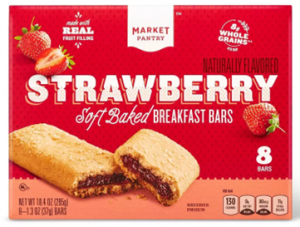
Now, If the food contains both a characterizing flavor from the product whose flavor is simulated and other natural flavor that simulates, resembles, or reinforces the characterizing flavor, the name of the food shall be immediately followed by the words “with other natural flavor.” So, this is how we arrive at “naturally flavored with other natural flavors” like in the example below.
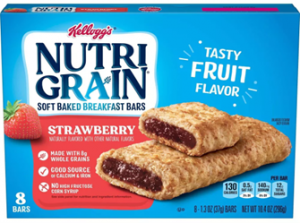
4. Why don’t the calories add up?
If you are someone who counts calories, you may have noticed that they don’t always add up the way you’d expect them to. Typically, you can do a quick calculation multiplying the grams of carbs and protein by 4 calories and the grams of fat by 9 calories to get to the approximate number of total calories in a food product, but this isn’t always the case.
This is because a general factor of 2 calories per gram for soluble non-digestible carbohydrates (soluble fiber) is used on the nutrition label and 0 calories per gram for insoluble non-digestible carbohydrates (insoluble fiber). For example, you can see on the nutrition label for the high fiber tortillas below if you were to add up 4 cal/gram for protein and carbohydrates and 9 cal/gram for fat you’d be at a total of about 120 calories per serving, but if you count the 15g of fiber at 0-2 cal/gram since it doesn’t actually contribute 4 calories per gram to the body, that’s how you arrive at the listed 70 calories per serving.
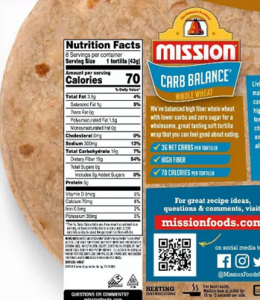
Hopefully this clears up a bit of the confusion regarding some of these less straightforward food labeling regulations. Incorrectly labeled food products do happen from time to time, but in many cases what may seem like an incorrect label is just a result of a more complex food labeling regulation.
Food Science Babe is the pseudonym of an agvocate and writer who focuses specifically on the science behind our food. She has a degree in chemical engineering and has worked in the food industry for more than decade, both in the conventional and in the natural/organic sectors.



